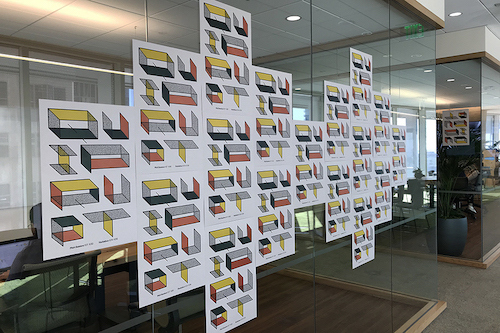When you’re building the ultimate collaboration solution, you need to know the ins and outs of collaboration. That’s the approach our Quip team takes with adding new features to their platform. And by “Quip team”, I’m talking about everyone who works on Quip from sales, marketing, and other business teams, to the engineers, and product managers.
Since 2016, Quip, our collaboration platform, has become an integral part of the Customer Success Platform, fueling real-time conversations, teamwork, and actionable results. Just like the other product teams here at Salesforce, they’re driving innovation daily, however, every spring and fall they drop everything to focus their time and energy on bringing projects they’ve dreamt up to fruition. Thus, Quiprupt was born.
But why Quiprupt?
A portmanteau for Quip and disrupt, Quiprupt is a three-day hackathon. It’s a time to take ideas further and make Quip the best product not only for customers, but also the team themselves.
“Our hope is that [our employees’] passion will also convert to a few extremely useful product features for our customers, or at the very least, give everyone a chance to put their product hats on and walk away with a sense of empowerment,” Engineering Manager Kurchi Hazra says.
The idea for Quiprupt was born out of listening. Kurchi explains, “Everyone has ideas and feedback. I’ve had conversations with both developers and people on the business side, but it can sometimes be difficult to get everyone aligned to make something happen, or there isn’t enough time to work on a side project.”
The first Quiprupt in March 2018 yielded 15 pitched projects with six of them rolling out to customers, including Document Version History, Tasks, and Editable Comments. “Quiprupt has been well-received by everyone. It’s a way for leadership to encourage engagement and amplify all voices. It’s also liberating for our teams who can work on passion projects and get a small win on the side,” Kurchi says.

Stop, collaborate, and listen
After initial ideas are pitched and teams are formed, everyone gets to work. Teams huddle in communal spaces taking the occasional break to eat celebratory treats. Each team has different flexible roles to fill, with all employees pitching in: for example, builders who develop an idea, pitchers who work on the pitch session, project managers to keep everyone on track, and captains to helm it all.
”We all hear different things, have different ideas, and bring different talents and skills to the table. We all have a passion for making Quip the best product for ourselves and for our users,” says Program Specialist Hira Rizvi.
There are few rules: 1.) Maximum 10 people total with a maximum of five engineers per team and 2.) No pre-coding allowed. You must demo using what you created in the three days.
At the end of the hackathon, 21 projects would be presented, but only one team would walk away with bragging rights and a fancy, selfie-taking flying robot.
Demo Day: Puns, Cupcakes, and N’Sync
The jokes, banter, and cheering began almost immediately on Presentation Demo Day. Having pushed back this celebratory day due to the San Francisco Bay Area’s severe air quality, teams were itching to share their work. Colleagues gathered in the social lounge with snacks and beverages to cheer on project teams through applause, appreciative whistles, and verbal encouragement. Co-hosts Software Engineer Claire Johnson and Strategy & Analytics Manager Marina Camim peppered the crowd with fake trivia full of in-jokes between demos, and played presenters off the stage with music à la televised award shows.
Presenters each had a few minutes to pitch their project and demonstrate what it would look like in a Quip testing environment. Sometimes people were pushed out of their comfort zones with engineers pitching and presenting, and salespeople disseminating technical information. It didn’t matter; the good-natured audience took technical difficulties and dramatic flourishes in stride.
Projects would be voted on in these six categories:
- #?: The most ambitious and/or creative project
- Productivity Booster: Best internal tool, automation, or code refactor
- Customer Love: Best demonstration of commitment to customers
- Mobilize Quip: Best mobile feature improvement
- Product Makeover: Best makeover for an existing Quip feature
- Grand Prize: The grandest of projects
With the wide breadth of categories, projects varied from user experience updates, to net-new features, to user interface re-designs, to artificial intelligence-driven task automation. There would be no leadership judging panel here; everyone would get to select their favorites through a blind vote.
Coming to a Quip near you
“It would be cool if…” is how many Quiprupt ideas are born, but not all of them are destined for release. Many factors are involved in getting shipped. What project doesn’t need much more work? If it needs more work, how much more work — 20% versus 70% more? Who will do that work, and so on? For now, teams will work with leadership to talk about what’s possible and what’s not. Just because a project doesn’t make it into the next release doesn’t mean it’s gone for good.
In the end, Quiprupt’s not really about the things created, it’s about the people. “It’s all about cross-collaboration,” Kurchi says. “A marketer can be a project manager. An engineer can be a showman giving a compelling demo. You can wear whatever hat you want as long as you’re working together to envision what Quip could be.”
Catch up on the latest with Quip. Click here to read the Quip blog and get the most up-to-date product information, productivity trends, and collaboration tips.




























